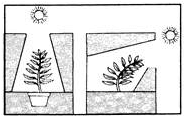Olympiad Test: The Living Organisms - Characteristics & Habitats - Class 6 MCQ
20 Questions MCQ Test Online MCQ Tests for Class 6 - Olympiad Test: The Living Organisms - Characteristics & Habitats
How does a chameleon protect itself from its enemies?
Which statements are true about the tree in hilly areas?
The plant in the given figure responds to


Which is the major component of the living environment?
The following is a list of some plants and the habitat in which they live. Which option is mismatched?
Which term means 'Adjustment to environment?
Which option is not an adaptation of animals living in polar regions?
Which characteristics protect an animal against cold weather?
(i) Thin skin.
(ii) Thick skin or fur
Which adaptation helps the camel to survive in hot and dry desert?
Environment consists of which of the following things?
Which of the following is represented by "X" in the figure given below?

Which characteristic of living things is also shown by a car?
Which pair has not been correctly paired?
Which of the following is an abiotic component of habitat?
Which is of the following is not exclusive only to living organisms?
In which habitat, animals with thick fur are most likely to be found?
Which is of the following is not a characteristic feature of aquatic plants
Which organism depends on abiotic components for food?
Organisms can breathe through
The plants undergo excretion by
|
252 tests
|














